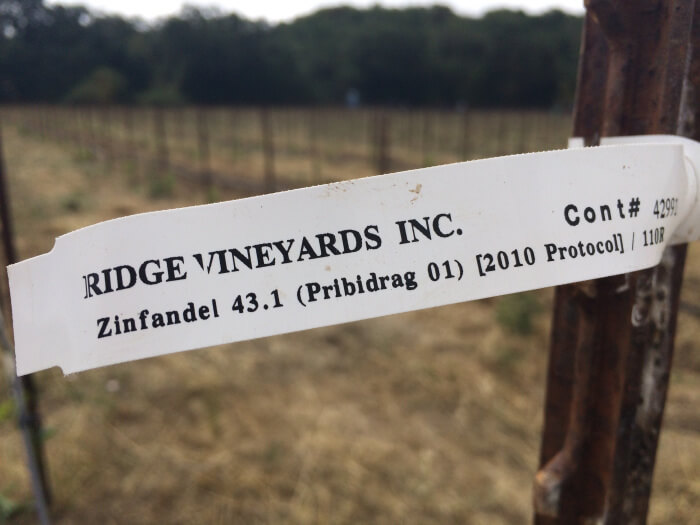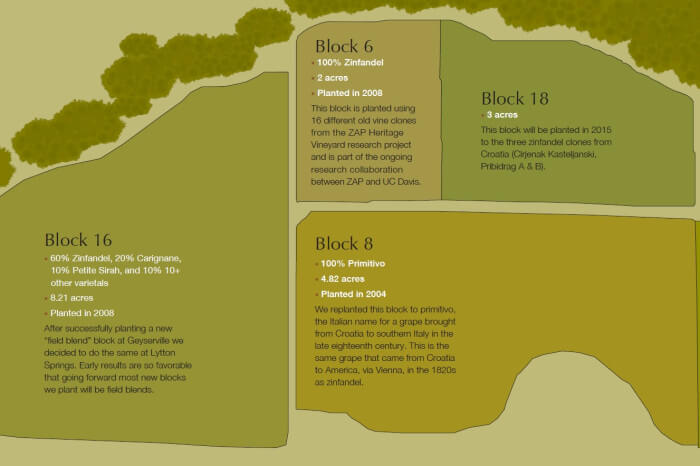Croatian Zinfandel Clones Planted at Lytton Springs
Blog Post
Our first Croatian clones, including Crljenak Kasteljanski and Tribidrag/Pribidrag, were planted at Lytton Springs on July 18th, 2015. This was the culmination of a long exploration into the origin of the zinfandel, which was ultimately found to be from the Dalmation Coast of Croatia. Ridge was intimately involved in this research project in the late 1990s and early 2000s, which allowed us to bring back clones of this grape to plant in our own vineyards.

History of Zinfandel and the Croatian Discovery
Paul Draper described these events in a newsletter from the summer of 2003:
“At Ridge, we tried from the outset to trace zinfandel’s origins. We discovered that it had been brought to our east coast in the 1820s from the royal collection at Klosterneuburg, near Vienna, which included plants from all parts of the Austro-Hungarian Empire. (Of subsequent interest: Croatia was a part of that empire.) Beyond that, our research faltered. A look-alike, called primitivo, was found in southern Italy by Dr. Goheen of UC Berkeley. Further study by UC Davis’ Dr. Olmo found primitivo to be identical to zinfandel, but his researchers reported that older growers in Italy referred to primitivo as a “foreign” grape. In 1998, geneticist Dr. Carole Meredith (UC Davis) investigated claims that the Croatian plavac mali was identical to zinfandel. Working with two scientists from the University of Zagreb, she determined this was not the case, but genetic testing did prove that they share half of their DNA: they are clearly related. In the fall of 2001, the Croatian researchers found a vine, called crljenak (tzerl-yen’-ak) Kasteljanski, which proved identical to zinfandel. By fall 2002, eight vines had been confirmed in one vineyard, and several other strong candidates were under investigation. In June 2002, Ridge—among others—helped fund a California visit for the two Croatian researchers. We also organized financing for the continuation of their investigations in Croatia. David Gates, our Vice President of Vineyard Operations, visited them there in summer 2003.”
–Paul Draper
David Gates continued on in that 2003 newsletter:
“It was a surreal experience, standing next to the most famous grapevine in Croatia with its owner, Ivica Radunic, and the men who discovered it, Dr. Edi Maletic and Dr. Ivan Pejic from the University of Zagreb. Called ‘crljenak Kasteljanski,’ it is unmistakably zinfandel, right down to its lyre-shaped sinus and large, fuzzy leaves. In this vineyard of six thousand vines, only eight crljenak vines have been found—remnants of a mixed planting by Ivica’s grandfather. Edi and Ivan believe that the Dalmatian Coast of Croatia could be the birthplace of zinfandel, and they have uncovered additional evidence to support this theory. Forty kilometers south of the crljenak vines there are two other locations where vines genetically identical to zinfandel have also been found. In a garden near a rock house at the edge of a mountain valley above Omis are five ancient vines locally known as ‘pribidrag;’ they currently provide table grapes. The historic name is tribidrag. There used to be more tribidrag here; wine made from it was famous a hundred years ago, before the fields were abandoned. If you could travel from this high, hanging valley directly over and down the grey limestone mountains, you would come to the Adriatic Sea and the town of Mimice, where at least ten tribidrag vines are growing. Wine of this name was renowned throughout the Adriatic region as far back as 1300. It is likely this wine was zinfandel.”
–David Gates

More on Tribidrag, Plavac Mali, and Babica Vines
Over the course of eight years, Edi and Ivan discovered numerous other Dalmatian Coast grapes genetically related to zinfandel. They include many important old varieties and several offspring, including “plavac mali” and “babica,” both widely planted all over Dalmatia today.
The total number of these related varieties suggests that zinfandel has been in this part of the world for many hundreds of years. If zinfandel was famous six hundred years ago as tribidrag, why is tribidrag almost extinct, and plavac mali, babica, and other varieties planted instead? It has to do with zinfandel’s fat, juicy berries and thin skin, which—in a European climate with summer and fall rains—make it highly susceptible to disease and rot.
Plavac mali, today the most widely-planted red wine grape in Dalmatia, inherited zinfandel’s vibrant fruit character, but not its fragile skin. It resists rot, carries good acidity, and has big tannins—essential to wine quality in this warm region. Growers are always on the lookout for vines that are both easy to care for and make good wine; plavac mali fit the bill.
Edi and Ivan believe that plavac mali was discovered between two and three hundred years ago, approximately the same time as cabernet sauvignon was discovered in Bordeaux. Once a wine grape that performs well in the vineyard and as wine has been identified, it takes less than a century for it to become a predominant variety.
Why does zinfandel succeed so well in California? The answer is California’s near-perfect climate, with summers and falls that are dry and sunny. Zinfandel won’t rot if there are not fall rains, and luckily fall rains are rare here. It can produce abundant, high-quality grapes with good acidity and color.
Zinfandel is also incredibly versatile, producing a spectrum of quality wines including rosés, light- and full-bodied reds, late harvests, and fortified wines. And finally, with the right vineyards and a deft touch in the winery, zinfandel yields beautiful, rich, fruity wines—unequaled anywhere in the world.”

Bringing the Croatian Vines to California
The process didn’t end there. In 2005, David Gates began working to bring cuttings of crljenak and tribidrag to the United States. Our goal was to plant them side by side with our American zinfandel selections, and an Italian primitivo clone, to see how each selection behaves on the same site.
Through Foundation Plant Services at UC Davis, we were able to import these cuttings and have them undergo a lengthy virus elimination process. That process has taken ten years, which concluded with the planting of these vines in block 18 on the western portion of our Lytton Springs vineyard.

Now a new process begins as these historic Croatian vines begin life in new soil, side by side with their American and Italian counterparts.
Wait!
In order to qualify for user related discounts, you must log in before proceeding with checkout. Click the button below to log in and receive these benefits, or close the window to continue.
Log In